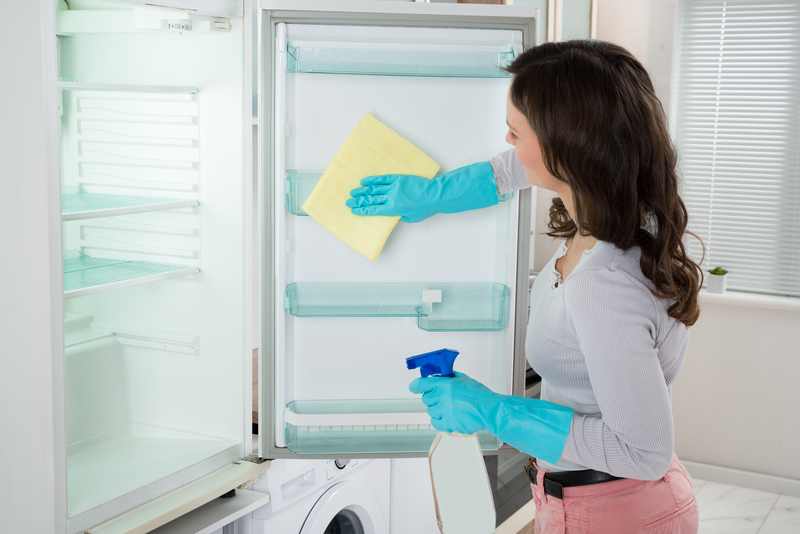Leave No Trace: Mould Removal from Window Sills
Posted on 18/08/2025
Leave No Trace: Mould Removal from Window Sills
Mould on window sills is an all-too-common problem for many homeowners and renters. Not only is mould unsightly, but it can also lead to health issues and damage to your home's structure. This comprehensive guide explores how to remove mould from window sills efficiently, prevent its return, and why it's critical to tackle this issue sooner rather than later.

Why Is Mould Growing On Your Window Sills?
Understanding why mould appears on window sills is the first step in addressing the problem. Here are some common causes:
- Condensation: Windows are susceptible to water vapour, especially in colder months when the warm indoor air meets the cold glass surface.
- Poor Ventilation: Lack of airflow increases moisture build-up, making window sills an ideal breeding ground for mould spores.
- Leaky Windows: Gaps or damaged sealants let rainwater and humidity in, providing the perfect environment for spores to thrive.
- Neglected Cleaning: Dust, dirt, and moisture on sills encourage mould growth if not cleaned regularly.
Without intervention, mould spores can damage wood, paint, and even the air quality in your rooms. Let's learn how to eradicate it for good.
How to Identify Mould on Window Sills
The first step in effective mould cleanup is proper identification. Mould can:
- Appear as black, green, brown or white spots on the window sills or frames
- Smell musty in the affected area
- Create a thin, fuzzy, or slimy layer on surfaces
If you notice any of these signs, it's time to take action to remove window sill mould immediately. Not all dark marks are mould, so confirm with a close inspection if possible.
Why Removing Mould from Window Sills is Essential
It might be tempting to ignore small patches of mould, but that would be a mistake. Mould removal on window sills is crucial for several reasons:
- Health Risks: Mould spores can aggravate allergies, trigger asthma, and cause respiratory issues.
- Property Damage: Mould can gradually weaken wood, paint, and plaster, leading to expensive repairs.
- Spread: If left unchecked, mould can quickly spread from your window sills to other areas of your home.
Thorough cleaning and preventative measures protect your family and your home, making it essential to deal with window frame mould removal thoroughly and safely.
Safety First: Precautions for Mould Removal
Before you begin, remember that mould can be hazardous to your health. Always:
- Wear gloves, goggles and a mask to avoid skin and respiratory exposure
- Ensure proper ventilation
- Keep children and pets away from the area
- Do not mix cleaning products, especially bleach and ammonia
*If the area is over 1 square metre or if you have toxic black mould (Stachybotrys), consider calling a professional*
Step-by-Step Guide: Mould Removal from Window Sills
What You'll Need
- Protective gloves, mask, and goggles
- Old towels or drop cloths
- Bucket of warm water
- Soft-bristled brush or scrub sponge
- Microfiber cloths
- White vinegar or a commercial mould remover
- Baking soda (optional for stubborn stains)
- Spray bottle
Cleaning Solution Options
- White vinegar: Undiluted vinegar kills 82% of mould species and is safe for most surfaces.
- Baking soda: Effective for scrubbing and deodorizing.
- Hydrogen peroxide (3%): Kills mould and is less harsh than bleach.
- *Avoid using bleach on porous surfaces like wood, as it does not penetrate deeply and may cause damage.*
Steps for Removing Mould from Window Sills
- Protect the area - Lay towels or cloths around the window sill to protect flooring and nearby furniture.
- Ventilate - Open windows if possible to improve airflow and help dry out the area.
- Remove loose mould - Use a dry cloth or vacuum with a HEPA filter to gently remove loose spores; dispose of the bag immediately.
- Apply the cleaning solution - Spray undiluted white vinegar or your chosen cleaner directly onto the affected area. Let sit for at least 1 hour.
- Scrub the area - With gloved hands, use a soft brush or sponge to gently scrub away the mould. Rinse the brush frequently.
- Wipe and dry - Use a clean, damp cloth to remove residue. Immediately dry the window sill thoroughly with another cloth.
- Repeat if necessary - For persistent stains, sprinkle baking soda, spray vinegar, let fizz, and scrub again.
- Dispose of materials - Throw away used cloths, gloves, or sponges to avoid spreading spores.
These steps will remove window sill mould in most situations. For extensive or recurring mould outbreaks, professional remediation may be necessary.
How to Prevent Mould Return on Window Sills
Once you've achieved a clean slate, keep mould from returning by following these best practices:
- Reduce Humidity: Use dehumidifiers in rooms prone to condensation, especially bedrooms and bathrooms.
- Increase Ventilation: Open windows regularly or use trickle vents to promote airflow.
- Wipe Sills Regularly: Weekly cleaning keeps surfaces dry and mould-free.
- Seal Leaks: Repair any gaps in window frames or damaged caulking to prevent water ingress.
- Monitor for Condensation: Wipe away moisture each morning, especially in winter months.
- Use Moisture Absorbers: Place silica gel packs or other moisture-absorbing products on window sills in problem spots.
By reducing moisture and performing regular maintenance, you'll win the battle against window sill mould for good.
Natural vs Chemical Mould Removers: Pros & Cons
Should you use natural mould removers or commercial chemicals on your window sills? Here's a comparison:
Natural Options
- Vinegar - Cuts through most household mould safely and gently.
- Baking Soda - Mild abrasive, deodorises, and works well combined with vinegar.
- Lemon Juice - Mildly antibacterial, though not as potent as vinegar.
Pros: Eco-friendly, safe for pets/kids, inexpensive.
Cons: May require more scrubbing, less effective for large infestations.
Chemical Cleaners
- Commercial mould removers and sprays - Designed specifically to kill stubborn mould and mildew.
- Hydrogen Peroxide (3%) - Fights deeper stains, less toxic than bleach.
Pros: Stronger, faster-acting.
Cons: May produce fumes, possible irritation, not suitable for all surfaces.
Whichever method you choose, do a small test patch first on your window sill to avoid accidental damage.
What About Wooden Window Sills?
While many window sills are plastic or painted, wooden window frames and sills can harbour mould deep in the grains. Here's how to handle them:
- Avoid excess water during cleaning; use a slightly damp cloth only.
- Sandal lightly if the mould has penetrated the surface, then repaint or reseal.
- Apply vinegar (not bleach) to kill spores without warping the wood.
- Refinish as needed to protect the wood and prevent future outbreaks.
If you suspect severe mould beneath the paint or wood surface, consult a restoration expert for safe remediation.
When to Call a Professional for Mould Removal
DIY methods work for small patches of mould but sometimes professional mould remediation is necessary:
- The affected area is larger than 1 square metre
- Mould has penetrated into walls, floors or wooden window frames
- Family members experience persistent respiratory or allergic symptoms
- Toxic black mould is present (appears slimy, very dark, and spreads quickly)
Experienced mould removal contractors have specialised equipment, advanced cleaning agents, and can repair structural damage and stains that household cleaners can't reach.
Frequently Asked Questions: Window Sill Mould Removal
Can I use household bleach to clean window sill mould?
Bleach kills surface mould on non-porous materials but does not penetrate wood or painted surfaces effectively. It also leaves behind water that can feed new mould growth. Vinegar or a commercial mould remover is safer and more effective on window sills.
How do I remove mould stains from window caulking?
Apply white vinegar or hydrogen peroxide directly to the stained caulking. Soak for 30-60 minutes, then scrub with a small brush. For persistent stains, replace the caulking with a mould-resistant silicone sealant.
What causes mould to keep returning on my window sills?
Moisture is the key factor. Be sure to address leaks, condensation, and humidity - otherwise, even after thorough cleaning, mould may quickly return. Regular maintenance is essential.
Is mould on window sills dangerous?
While not all household moulds are toxic, many can trigger allergies, breathing problems, and other health concerns, especially for children and the elderly. *Always remove visible mould promptly and keep rooms well-ventilated.*

In Summary: Leave No Trace With Window Sill Mould Removal
Dealing with mould on window sills doesn't have to be daunting. With the right tools, cleaning agents, and prevention techniques, you can eliminate every trace of mould and enjoy healthier, brighter indoor spaces.
- Act quickly when you spot mould to minimise damage and health risks
- Use safe, effective cleaning solutions such as vinegar or commercial mould removers
- Regularly maintain your windows to prevent future mould growth
- Seek expert help if mould covers large areas or recurs despite your efforts
By following this comprehensive guide to window sill mould removal, you'll ensure that no trace of mould is left behind, keeping both your home's appearance and air quality in top condition throughout the year.




